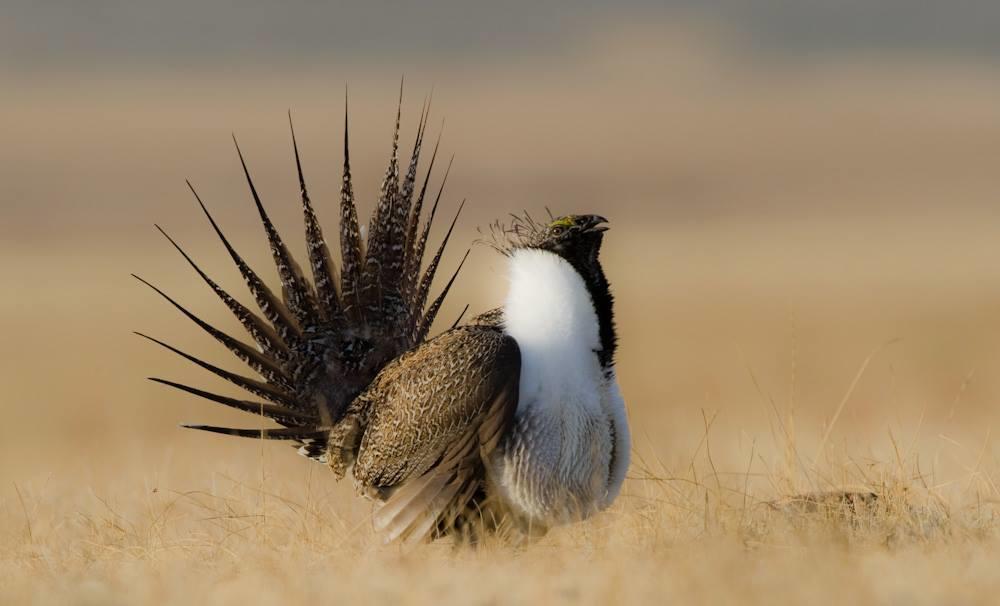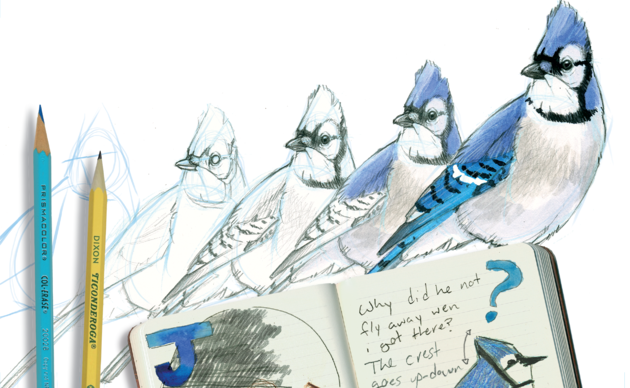Greater Sage-Grouse

The Greater Sage-Grouse is one of North America’s most fascinating, and threatened, birds. With its spiked feathers, unusual mating rituals, the bird prefers desolate habitat of the Western United States.
The Greater Sage-Grouse is well named, for it is quite dependent on sagebrush. In the fall and winter the leathery leaves of sagebrush are one of its only foods, and during the rest of the year sagebrush provides it with cover. Each spring the males gather on a traditional display ground, called a lek, to court the females. Once a female has mated, she goes off and raises her family by herself.
Males are typically 26-30 inches and females, 22-23 inches. Both sexes are a mottled gray-brown above with black belly. Males have a long pointed tail, black throat, white breast, with elongated neck plumes flanking breast. The female's head, back, and breast uniformly barred. Displaying male fans tail and tilts it forward; inflates pair of naked yellowish-green air sacs in neck and breast. When flushed, the bird will make a chicken-like cackling call. Males make bubbling sound during courtship. Females lay 6-9 olive-green eggs that are lightly spotted with brown, in a well-concealed grass-lined depression.
Historical population is estimated to have been in the millions; its current population is estimated between 250,000 and 500,000. Audubon's WatchList categorizes the species as "Yellow" - indicating that it is rare or declining.
The major threat to Greater Sage-Grouse is the continued degradation and destruction of sagebrush habitat. Much habitat has been destroyed for farming or development, or degraded by grazing or invasive plants. Oil and natural gas drilling renders even good habitat unusable.
Their dance
A lek is a traditional breeding ground and behavior; the name is derived from the Swedish word for "play." Greater Sage-Grouse return to the same leks year after year, like salmon returning to their spawning grounds. In fact, some leks may have been the site of the sage-grouse's elaborate springtime courtship display for thousands of years. The loss of a lek, to flooding, agriculture or energy development, or other habitat destruction, has profound consequences for the grouse who return to it each year.
The Greater Sage-Grouse display is among the most complex of bird mating rituals. Dozens of males strut, fan their tail features, and pop the yellow air sacs on their breasts to create a "wup" sound that can be heard two miles away. Beginning around dawn, and peaking in intensity at the time of the full moon, males display for three to four hours. A single male may mate with 20 females in one morning. All this activity requires a lot of energy, and males lose a significant amount of body weight during breeding season.
The annual event has inspired the Grouse Dance performed by several Plains tribes of Native Americans, in which drums imitate the rhythms of the male sage-grouses' air sacs. Other birds, including peacock, Wild Turkey and birds of paradise, as well as antelopes and at least one fish species also lek.
How you can help, right now
Get Audubon CA in Your Inbox
Our newsletter is fun way to get our latest stories and important conservation updates from across the state.
Donate to Audubon
Help secure the future for birds at risk from climate change, habitat loss and other threats. Your support will power our science, education, advocacy and on-the-ground conservation efforts.
HOTSPOT: Flyover of California's Birds and Biodiversity
California is a global biodiversity hotspots, with one of the greatest concentrations of living species on Earth.





